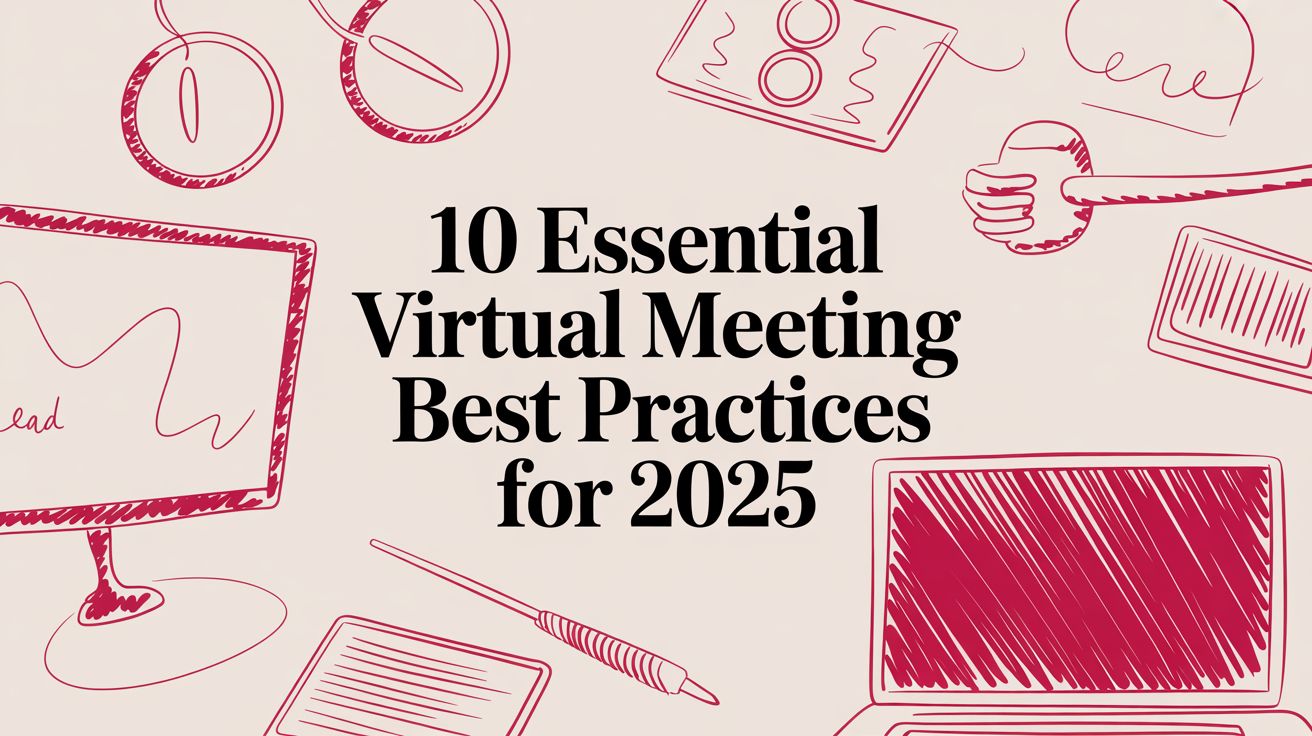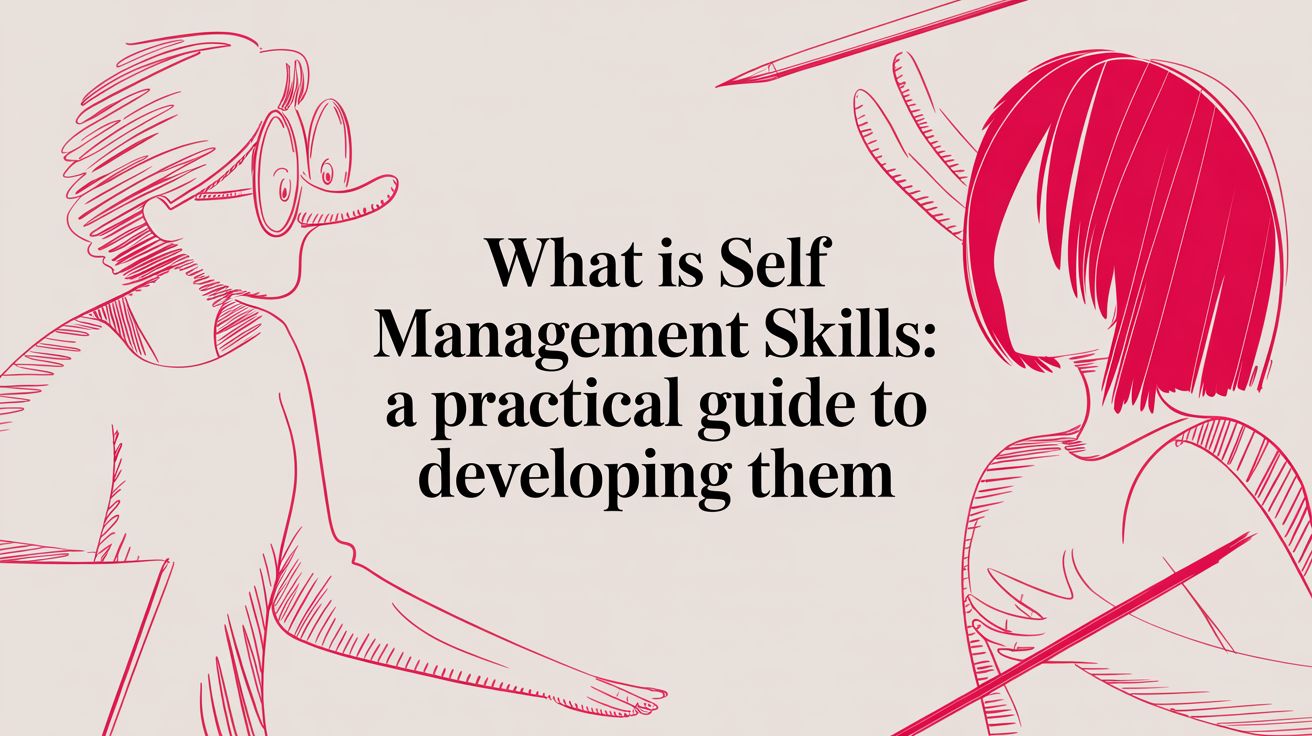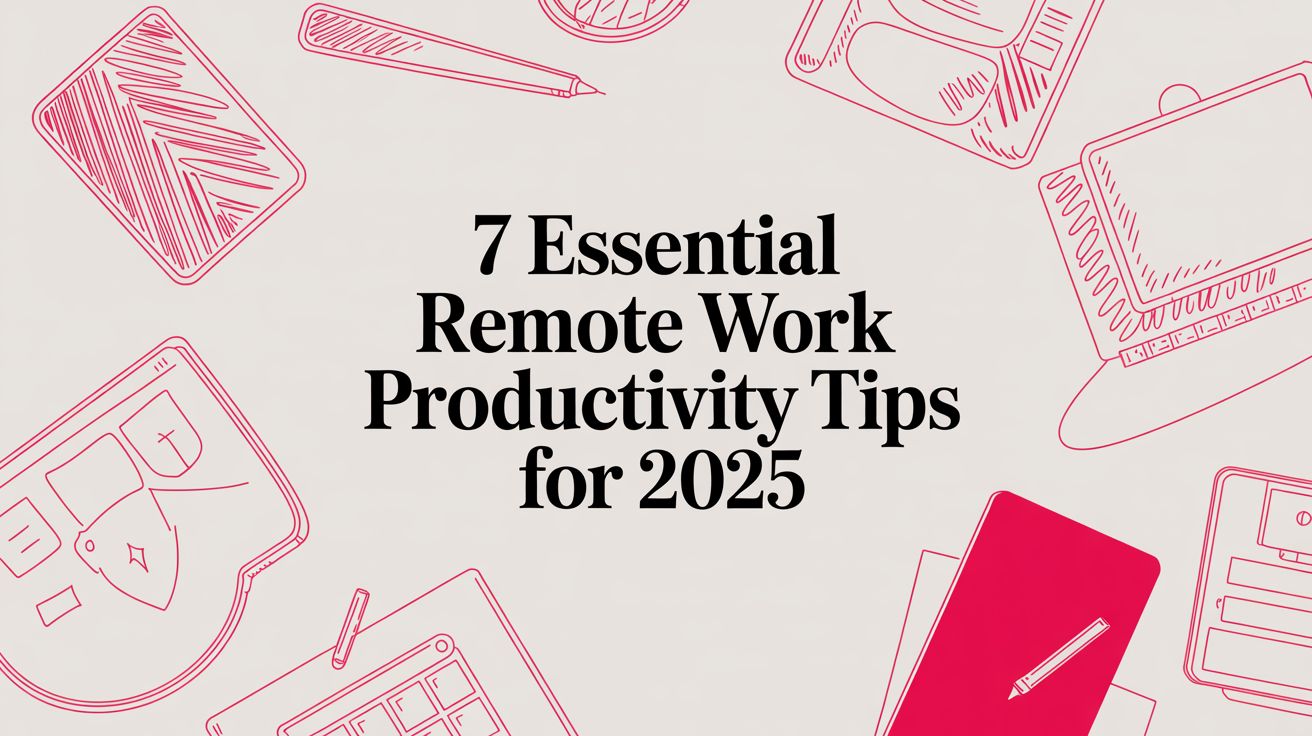Create a Good UX Portfolio That Impresses Recruiters
Max
Think of your UX portfolio as more than just a gallery of pretty designs. It’s your single most important career tool—a strategic story that proves your value as a problem-solver. For anyone aiming for a remote-first job, this is what gets your foot in the door.
Why Your UX Portfolio Is a Career Multiplier
Let’s get one thing straight: a portfolio isn’t a static collection of images anymore. Hiring managers, especially at top-tier companies, are looking for a window into your mind. They aren’t just glancing at the final product; they’re digging into your entire problem-solving journey. A good UX portfolio shows them exactly how you think, adapt, and ultimately, create value.
This shift in focus is everything. Your portfolio’s main job is to prove you’re not just a designer but a strategic partner who can directly influence business outcomes. It needs to answer the real questions running through a recruiter’s mind:
- How do you tackle a messy, ambiguous problem?
- Can you work within real-world constraints, like a tight budget or tricky technical limitations?
- How do you collaborate with other teams, especially when everyone’s remote?
- And the big one: what was the measurable impact of your work?
From Designer to Strategic Thinker
The best portfolios I’ve seen all have one thing in common: they tell a compelling story. Each project is framed around a core challenge, walking the reader through every step you took to land on a solution. This narrative is infinitely more powerful than just showing off polished, context-free mockups. It’s the difference between showing what you designed and explaining why it mattered and how it succeeded.
This focus on strategic thinking is a direct reflection of where the industry is heading. The global UX services market was valued at $2.59 billion in 2022 and is expected to explode to $32.95 billion by 2030. That’s not just growth; it’s a clear signal that companies are betting big on user experience to drive their bottom line. For designers, this means a portfolio that highlights strategic impact is no longer a “nice-to-have”—it’s your ticket to standing out. You can dig deeper into these UX industry trends to get a feel for the competitive landscape.
A great portfolio doesn’t just show off your skills; it builds a rock-solid case for why a company needs to hire you. It bridges the gap between your design files and their direct contribution to user happiness and business growth.
Ultimately, your portfolio is your advocate in rooms you haven’t even entered. It needs to clearly spell out your value, demonstrating a mature grasp of how user needs and business goals connect. When you frame your work this way, you don’t just find a job—you multiply your career opportunities.
To help you get started, here’s a breakdown of the key elements that transform a simple portfolio into a powerful career tool.
Key Elements of an Impactful UX Portfolio
| Portfolio Element | Why It Matters | Example |
|---|---|---|
| Problem Statement | Sets the stage and shows you understand the business context, not just the design task. | “The e-commerce app’s checkout conversion rate was 15% below the industry average, leading to significant revenue loss.” |
| Your Role & Team | Clarifies your specific contributions and demonstrates your ability to collaborate. | “As the lead UX designer, I collaborated with a PM, two engineers, and a data analyst to…” |
| Process & Rationale | This is the core of your story. It reveals your thought process and decision-making skills. | “We started with user interviews, which revealed three key pain points. This led us to prototype and test two different navigation flows…” |
| Constraints & Trade-offs | Shows you can work in the real world, not just a perfect-world scenario. It builds credibility. | “With a two-week deadline, we had to prioritize mobile-first and defer desktop optimizations for a later sprint.” |
| Measurable Impact | The proof your work delivered value. It connects your design directly to business goals. | “After launch, checkout conversions increased by 22%, and user-reported satisfaction scores went up by 35%.” |
Focusing on these elements will ensure your portfolio tells a compelling story that resonates with hiring managers and proves you’re ready to make a real impact.
Crafting Case Studies That Tell a Compelling Story
Your case studies are the heart and soul of your UX portfolio. They’re what separate a simple project gallery from a powerful narrative that showcases your problem-solving chops. A hiring manager isn’t just scrolling through your final mockups; they’re trying to understand the journey you took to get there.
Think of each case study as a story with a clear beginning, middle, and end. Your goal is to hook the reader with a compelling challenge, clearly define your role in tackling it, and then walk them through your design process. This approach is infinitely more engaging than a dry list of deliverables.
Frame the Problem and Your Role
Every great story needs a conflict to get things started. Begin your case study by setting the scene. What was the core business problem or user frustration you were hired to solve? Get specific. Instead of a vague “the app was hard to use,” try something like, “users were abandoning their carts at a rate of 70% because of a confusing and lengthy checkout process.”
Right after establishing the problem, clarify your specific role and contributions. Were you the lead designer on a team of five? A solo UX researcher? This context is critical, especially for remote-first employers who need to know how you operate within different team structures.
A strong problem statement does more than just introduce the project—it demonstrates your ability to grasp business objectives and connect them directly to user experience challenges. It shows you think strategically from the very beginning.
This chart breaks down a simplified workflow for how I think about structuring case studies, focusing on picking the right projects, generating insights, and measuring impact.
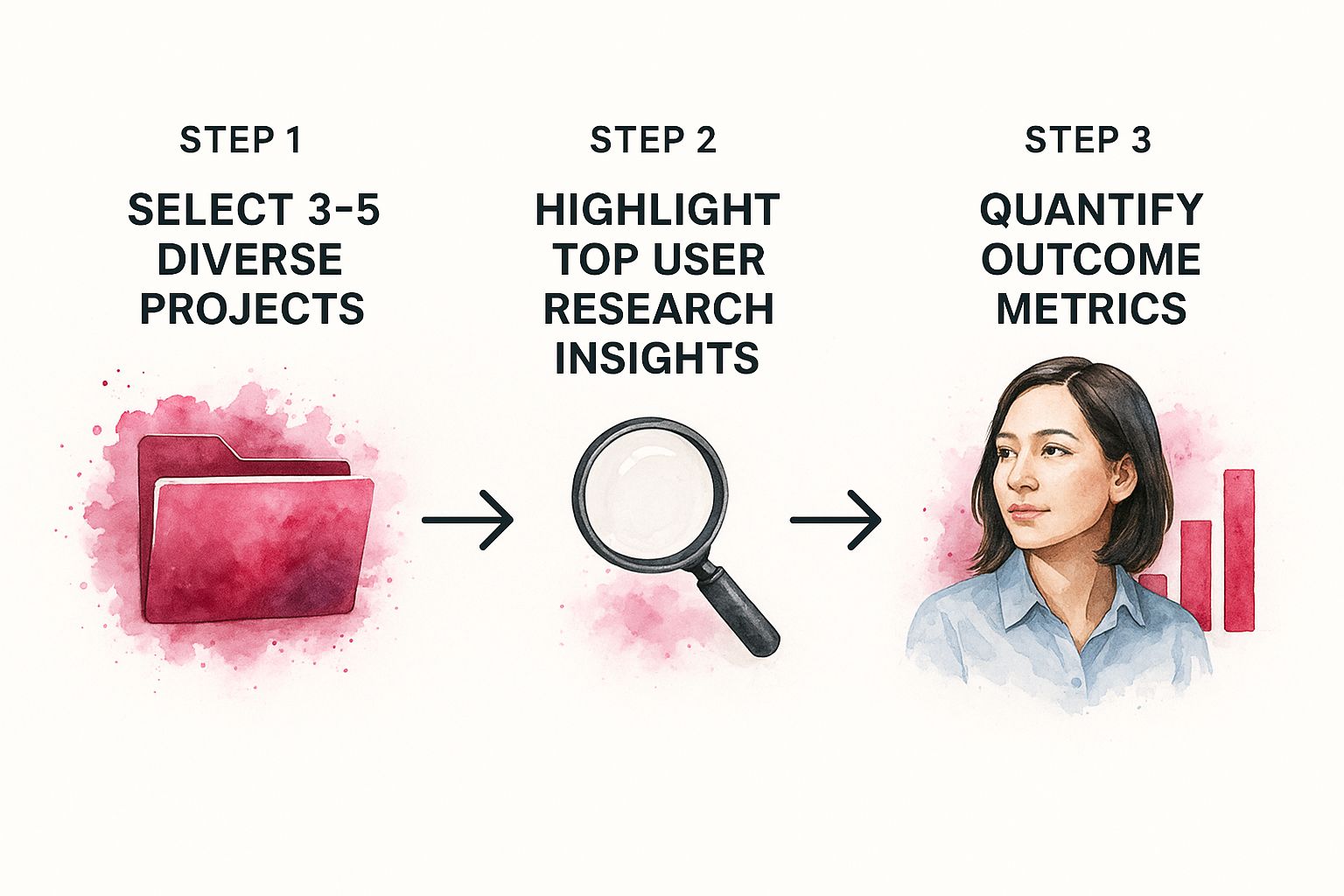
This flow really highlights the importance of starting with a curated selection of diverse projects, digging deep into the most critical user research, and finishing strong by proving your value with hard data.
Showcase Your Process and Rationale
This is where you show, not just tell. Guide the reader through your design journey, but be selective about it. You don’t need to dump every single wireframe or user interview transcript into your portfolio. Instead, cherry-pick the artifacts that best support your narrative and demonstrate your thinking.
What key insights from user research drove your initial design concepts? How did usability testing feedback force you to pivot? You need to connect every design decision back to a user need or a business goal. For example, you could show:
- Initial User Flow: Display how your first draft of the user flow aimed to simplify the original, convoluted process.
- A/B Testing Mockups: Show two different versions of a critical screen and explain why the winning design performed better, citing user feedback or data.
- Key Research Findings: Use a bulleted list to highlight the three most important pain points you discovered during user interviews.
This storytelling approach transforms your case study from a simple project overview into a memorable account of your impact. It’s a skill that directly translates to finding success, and you can learn more about the best way to find remote jobs by applying this same strategic thinking to your job search. A well-told story makes you unforgettable.
Demonstrating Your Value with Data and Metrics

Let’s be honest: showing off beautiful designs isn’t enough anymore. A truly good UX portfolio does more than that—it proves your work made a real difference. You need to connect your pixels to profit, showing that your solutions didn’t just look good, but they actually worked. This is all about demonstrating your value with a powerful mix of qualitative and quantitative data.
Weaving metrics into your case studies is how you prove your impact. This means you have to go beyond just your design files and find the data that tells the “before and after” story of your project. The most compelling narratives are always backed by hard numbers.
Sourcing Your Impact Data
So where do you get this data? Even if your project didn’t have a dedicated analytics guru, you can still find what you need. The trick is to be resourceful and proactive. Start by thinking about what was measured—or what could have been measured—to define success.
Here are a few places to start your treasure hunt for compelling metrics:
- Quantitative Data: This is your hard evidence. Think conversion rates, task completion times, error rates, and user retention. Even a seemingly small improvement, like a 5% increase in sign-ups, is a powerful testament to your work.
- Qualitative Data: This is what adds the human story to your numbers. Dig up quotes from usability testing, snippets from user feedback surveys, or even glowing reviews from the app store. This kind of data shows you understand the why behind user behavior.
If you weren’t handed this data on a silver platter, don’t be afraid to ask for it. Reach out to the product manager or a friendly engineer from the project. Showing you care about results is a massive green flag for any hiring manager. It shows you have the same collaborative mindset needed when hiring remote software developers, where clear, cross-functional communication is everything.
A case study without metrics is just a story. A case study with metrics is evidence. It transforms your role from a designer into a strategic problem-solver who directly contributes to the bottom line.
Framing Your Results for Business Value
Once you have your data, you need to present it in a way that resonates. Don’t just list a metric; explain what it actually means for the business. This is what separates a good portfolio from a great one—connecting your design improvements to tangible business outcomes. Your ultimate goal is to show how your work moved the needle on key performance indicators (KPIs).
Take a look at how you can frame your impact more effectively:
| Vague Statement | Data-Driven Statement |
|---|---|
| “I redesigned the checkout flow.” | “My redesign of the checkout flow reduced cart abandonment by 18%, which increased quarterly revenue by $50,000.” |
| “Users said the new dashboard was better.” | “Following the launch, the new dashboard achieved a 4.7⁄5 satisfaction score in user surveys, a significant jump from the previous 3.2⁄5.” |
This approach does more than just state facts; it builds a powerful case for your value. You’re not just showing what you did—you’re proving why it mattered. When you master this, your portfolio stops being just a collection of images and becomes your most powerful career-building tool.
Designing Your Portfolio for the Hiring Manager

It’s time to turn your design skills inward and focus on your most important project: your portfolio. Think of it as its own UX project, where your primary user is a busy, often overwhelmed, hiring manager.
A good UX portfolio isn’t just a gallery of your work; its design, structure, and flow are a direct reflection of your professional capabilities. Your goal is to create a completely frictionless experience that makes your value obvious from the moment the page loads.
This all starts with a logical information architecture. A recruiter should land on your homepage and, within seconds, know who you are and how to find your best work. Make your case studies the hero of your site, using clear navigation labels like “My Work” or “Case Studies” so there’s no guesswork involved.
Remember, the entire experience has to be scannable. Hiring managers spend minutes—sometimes only seconds—on a portfolio. Use sharp headings, concise copy, and powerful visuals to pull their eyes exactly where you want them to go.
Building Trust Through Technical Excellence
Your professionalism isn’t just judged by your case studies. It’s also judged by the fundamental usability of your portfolio site. Small technical details can either build trust or shatter a first impression in an instant.
For example, mobile optimization is non-negotiable. A huge number of recruiters will first open your portfolio on their phone, so a clunky or broken mobile experience is an immediate red flag. It tells them you don’t consider all user contexts.
Beyond the layout, the quality of your visual assets speaks volumes. Using AI image enhancement techniques can ensure every screenshot and mockup is crisp, clear, and professional-looking. Don’t let blurry images undermine your beautiful design work.
Another simple but critical element is site security. A portfolio without a valid SSL certificate (the little lock icon in the browser) signals a lack of attention to detail, which is a major flaw for any UX designer.
A seamless, secure, and responsive portfolio does more than just present your work; it demonstrates your commitment to user experience principles before a hiring manager even reads a single word.
Aligning Design with User Expectations
Your portfolio’s design should be informed by established user expectations, and the data on user behavior is crystal clear on this.
For example, research consistently shows that 38% of people will stop engaging with a website if the layout is unattractive. This stat alone reinforces the need for a visually engaging and intuitive design. It has to look the part.
Similarly, other studies have found that a massive 68% of users will leave a site that feels insecure—like one missing that SSL certificate we mentioned. And since mobile browsing is king, it’s also worth knowing that 80% of users find it easier to make purchases on mobile-optimized sites. This behavior translates directly to how they interact with professional content, including your portfolio.
When you treat your portfolio as a full-fledged UX project, you’re making a powerful, silent argument for your skills. It shows you don’t just talk about good design—you live and breathe it.
Optimizing Your Portfolio for Remote Opportunities
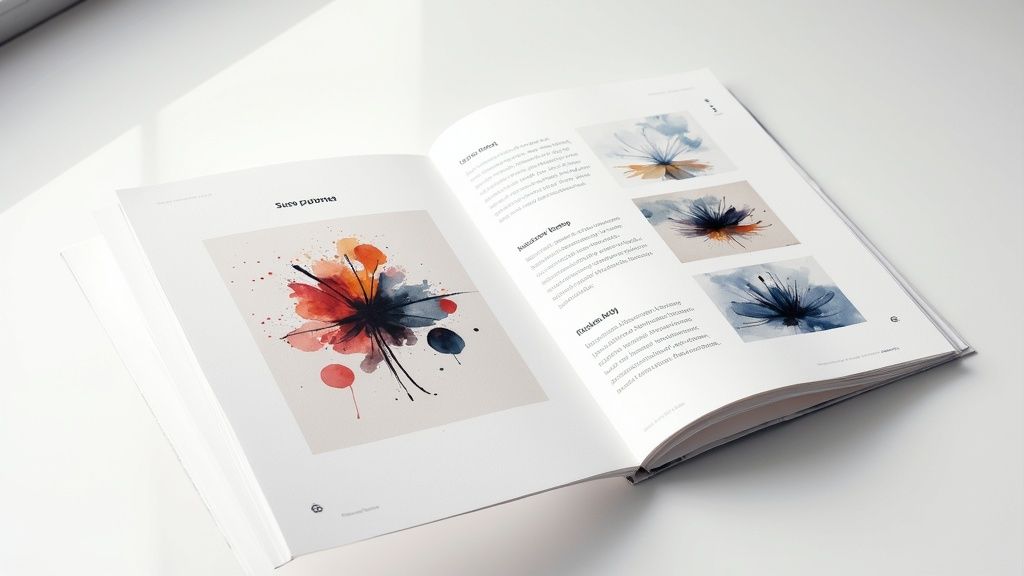
A solid UX portfolio today needs to do more than just show off nice designs—it has to speak the language of remote work. Companies aren’t just hiring down the street anymore; they’re building talented, distributed teams that span multiple time zones. Your portfolio is your primary tool to prove you can thrive in that kind of environment.
This means you have to be intentional about showcasing the specific skills that make remote collaboration work. It’s not just about your design chops, but about how you apply them when your team isn’t in the same room.
Highlighting Remote-Ready Skills
You have to make it painfully obvious that you get the nuances of working on a distributed team. Don’t just list your favorite tools. Instead, show exactly how you use them to bridge physical distances and keep projects moving forward.
Asynchronous Communication: Frame your case study narrative around how you kept everyone in the loop. Did you record detailed Loom videos to walk stakeholders through prototypes? Talk about that. Mention how you used crystal-clear written updates in Slack or Notion to maintain alignment without needing constant meetings.
Virtual Collaboration Mastery: Show, don’t just tell, your fluency with tools like Figma, Miro, or FigJam. I love seeing screenshots of a messy, collaborative whiteboarding session or a beautifully organized Figma file with a clear component library. This is tangible proof that you can jump into a remote team’s workflow and contribute from day one.
Demonstrating these skills shows hiring managers that you not only overcome the typical challenges of remote work but that you embrace the full spectrum of remote work benefits, leading to a more productive and autonomous workflow.
Your portfolio should act as concrete evidence that you are a self-sufficient, proactive communicator who doesn’t need constant hand-holding to deliver exceptional work. This is what remote-first employers are truly looking for.
Tailoring Your Work for a Global Audience
The UX world isn’t one-size-fits-all. What gets a hiring manager in Berlin excited might be different from what a team in Singapore is looking for. If you can show you understand these regional dynamics, you’ll have a serious advantage.
For example, Europe’s market is massive—it captured over 30% of global UX revenue at $17.04 billion. From what I’ve seen, teams there often place a high value on deep research and methodological rigor. On the other hand, the Asia Pacific market is exploding, with a projected 10.5% annual growth. Teams in that region might prioritize designs that drive rapid user adoption and clear business growth. You can dig into more of these global UX market statistics to find relevant data points.
So, how do you use this? Frame your case studies strategically. If you worked on a project with extensive user research for a European client, lead with that. If another project led to a huge spike in user acquisition in an emerging market, make those growth metrics the star of the show.
This approach shows you have the cultural and market awareness to design effective solutions for a global audience, not just a local one.
Avoiding Common Portfolio Mistakes
Even the most brilliant designers can get knocked out of the running because of a few simple portfolio mistakes. A huge part of building a good UX portfolio is learning to sidestep the common pitfalls that can completely undermine all your hard work.
One of the biggest blunders I see time and time again? Prioritizing quantity over quality. It’s far more impressive to present three deeply detailed case studies than it is to show off ten shallow project galleries with nothing more than the final mockups.
Another major red flag for hiring managers is a portfolio built on a generic, overused template. Your portfolio website is your very first design test. If it looks identical to dozens of others, it screams a lack of originality and attention to detail. Take the time to build an experience that truly reflects your personal brand and skills.
Writing with Clarity and Purpose
Your case studies have to be easy to read and digest. Seriously. Avoid writing dense, jargon-filled paragraphs that sound like they were ripped from a college textbook. Busy recruiters are scanning your content, not studying it for an exam.
Break up your text, use clear headings, and write in a direct, conversational tone. The goal is to make your problem-solving process accessible to everyone, from fellow designers to non-technical folks like product managers or executives.
Your portfolio should feel like an engaging conversation, not a final exam. If a recruiter needs a dictionary to understand your case study, you’ve already lost them. Clarity is your greatest asset.
Finally, always respect confidentiality. Never, ever display work that’s under a Non-Disclosure Agreement (NDA) without getting explicit permission first.
The professional and ethical way to handle this is to password-protect that specific case study. You can then offer to provide the password to recruiters when they request it. This one small step shows you’re trustworthy and professional—qualities that are just as important as your design chops. Thinking through these details is great practice, much like how you’d prepare for the interview itself. For more on that, check out these useful remote interview tips.
Common Questions About UX Portfolios
As you start wrapping up your portfolio, a few common questions always seem to surface. Getting these details right is what separates a good portfolio from a great one—the kind that’s polished, strategic, and ready to catch a hiring manager’s eye.
How Many Projects Should I Include?
This is where quality always trumps quantity. The sweet spot is 3-5 of your strongest, most detailed projects. Seriously, it’s so much better to have three killer case studies that tell a rich story than ten shallow project galleries with just a few pretty mockups.
Your goal should be to have each project show off a different skill or demonstrate how you tackled a unique business challenge. Pick the work you’re most proud of and can talk about with genuine excitement—that passion will absolutely come through.
Can I Use Student or Conceptual Projects?
Absolutely. Every hiring manager worth their salt knows we all have to start somewhere. A thoughtfully executed conceptual project can be just as impressive as one with a big-name client.
The trick is to give it the same professional treatment you would any other project. Build a complete case study around it. Define a clear problem, walk through your research and design process, and present a final solution backed by solid reasoning. Even without real-world metrics, you can articulate the hypothetical impact to prove you’ve got the strategic UX mindset they’re looking for.
Protecting confidential work is non-negotiable and a sign of professionalism. Password-protect the case study on your site and offer to share the password directly with recruiters upon request. This shows you’re trustworthy.
How Do I Show Work Under an NDA?
Showcasing work that’s under a Non-Disclosure Agreement is a balancing act. You need to respect your legal obligations while still highlighting your contributions. For your public portfolio, start by anonymizing everything—scrub the client’s name (try something like “a leading fintech startup”) and either blur, recreate, or omit any sensitive data or visuals.
Then, pivot the narrative to focus on your process. Talk about your specific role on the team, the problem-solving journey, and how you navigated things like stakeholder expectations or technical constraints. Detailing the how and why behind your decisions gives hiring managers incredible insight and helps improve the overall candidate experience you provide.
